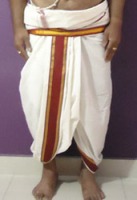We’ve all seen the women in brahmin families wear the Madisar with elegance and the men wearing Pancha Kachcham with confidence. Ever wondered why they wear these clothing specifically?
This week, we break down what Madisar and Pancha Kachcham signify and how beneficial they are to us.

Pancha Kachcham:
Traditionally, a Hindu wears Veshti/Dhoti which covers the lower part of their body. These are worn in different styles by different sects of Hindus. Pancha Kachcham is specifically prescribed only for “Grihastha” belonging to all the four Varnas. Pancha Kachcham (from the Sanskrit terms Pancha and gajam meaning “five yards” as the length of the Pancha Kachcham is five yards in contrast to the Veshti’s used in daily life which are four or eight cubits long).
Many times during performing rituals, one has to get up & do pradakshinas etc. These all require an ease in movements. The Pancha Kachcham is the most suitable garment for such occasions. Even the dead body of a Brahmin is clad in Pancha Kachcham because while going to heaven also a true Brahmin should be ready to perform his duties, on his way to & after having reached heaven, so this attire.
There are three Gunas (quality or virtue) –Rajas (passion, active, confused), Tamas (darkness, destructive, chaotic) and Sattva (goodness, constructive, harmonious). All of these three Gunas are present in everyone and everything; it is the proportion that is different, according to Hindu worldview. The interplay of these Gunas defines the character of someone or something, of nature and determines the progress of life.
Significance:
Pancha Kachcham – is not about yards as much as it is about tying the Veshti in 5 places (critical touch points with the body) to help the person (male in this case) performing the ritual keep all the 5 Indriyas (senses) under control and focus. The aim is to maximize Sattva Gunas keeping the other two Gunas (Rajas & Tamas) low during the performance of duties, rituals, Sandhyavandhanam and worshipping God. The dress code Pancha Kachcham is designed to enable a Grihastha to develop in him the right attitude towards when worn along with Anga Vastra. The dress code Pancha Kachcham simply enables to keep the Prakritic bodily elements tied up and under control.
Madisar:


The traditional married Brahmin woman is draped in a nine-yard saree, also known as Madisar. It is a symbol of her transformation from a girl to a woman who is now married. Normally sarees are six yards in length, but since the Madisar is worn in a different style, one requires a nine-yard saree to wear it. It is a very important part of the Iyer and Iyengar culture. Both Iyer and Iyengar Brahmin wear Madisars for all important occasions in their lives, starting with marriage, followed by Seemandham (form of a baby shower), all important poojas, and death ceremonies
Madi is the portion of the long pallu which is folded into two, lengthwise and tucked away at the back and this prevents it from slipping from the shoulder. The other word is Thaar. It means bringing a portion of dhoti or saree from front, between the legs and tucking it at the small of back. This will make the dhoti or saree like a pajama and helps free movement of legs. Also serves as a pair of pants. This word has now become ‘Saar ‘.
SIGNIFICANCE
Madisaar has a pressing not on both of hip nerves and behind backbone. This helps in pressing the nerves so that the woman who wears it do not feel hungry or thirsty. As there were more vrathams followed in those days, madisaar helps in making them less hungry and thirsty. And on festive occassions, you cannot take a pass in mid-session. Madisaar helps in controlling the process of excretion.
It is believed that Madisar especially the Kachcham (if you know to drape) at the back acts as a cushion to the lumbar area and it is exactly like that of the hip belt which orthopedics suggest for people with back ache. Also, Madisar cushions our uterus and acts as a shock absorber and that’s why our ancestors hardly had any miscarriage or infertility problems.
References:
https://hinduism.stackexchange.com/questions/9173/panchakacham-purpose
https://in.answers.yahoo.com/question/index?qid=20100823100745AAz3FVT
brahminrituals.blogspot.com/2013/06/rare-dharmopadesas-for-brahmins.html
indusladies.com › Forums › Topical Forums › Fashion › Clothing & Apparels
https://www.tamilbrahmins.com/showthread.php?t=8847
https://en.wikipedia.org/wiki/Madisar

